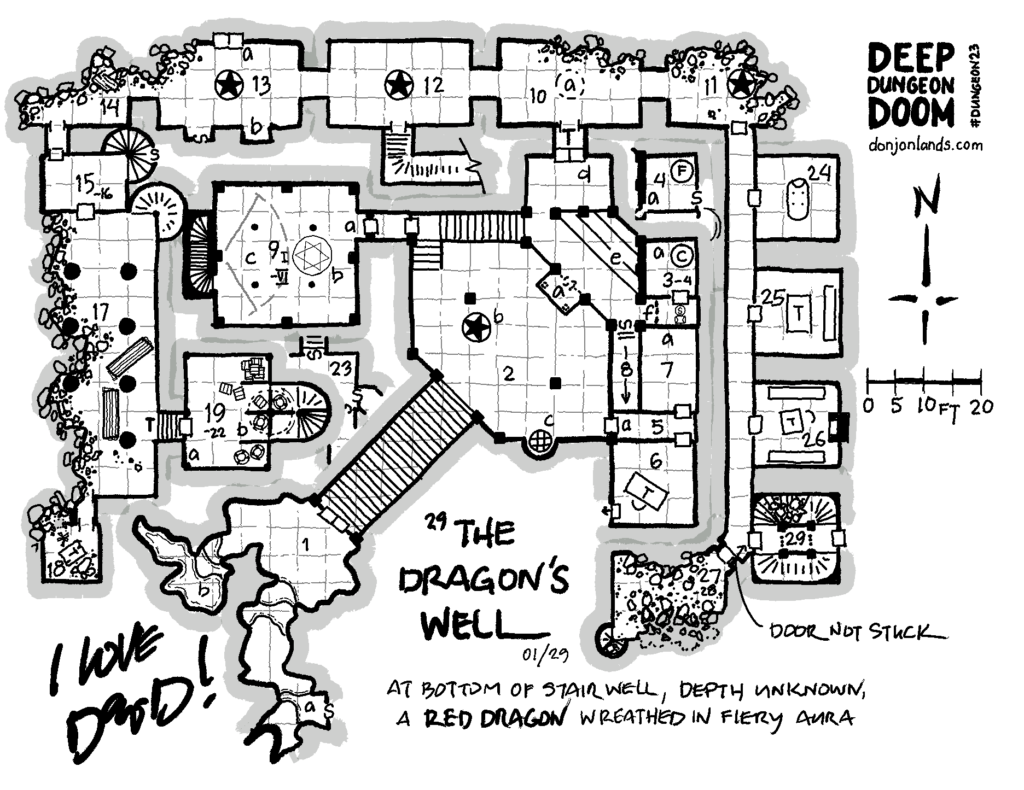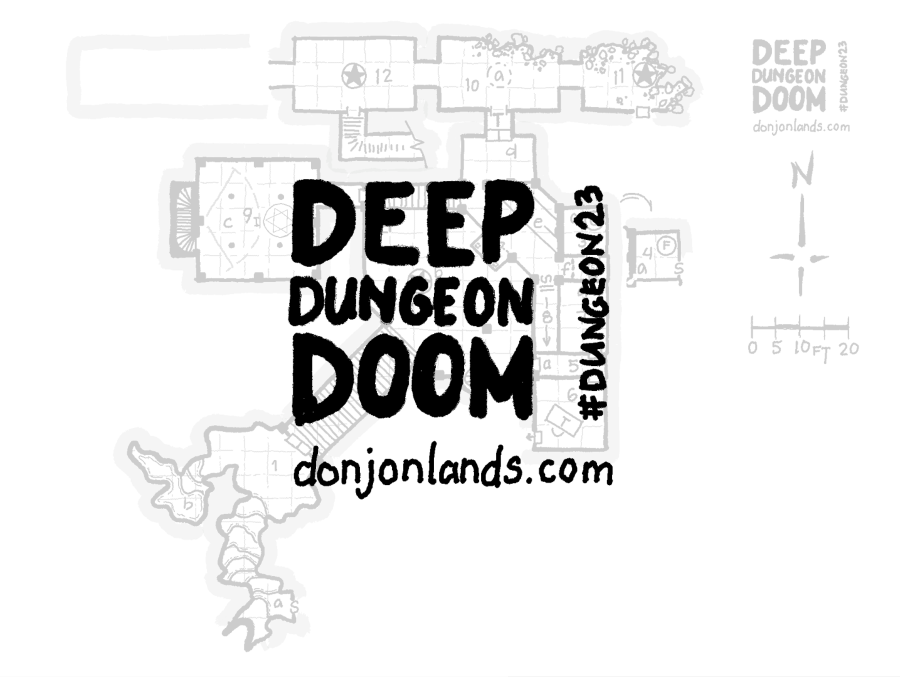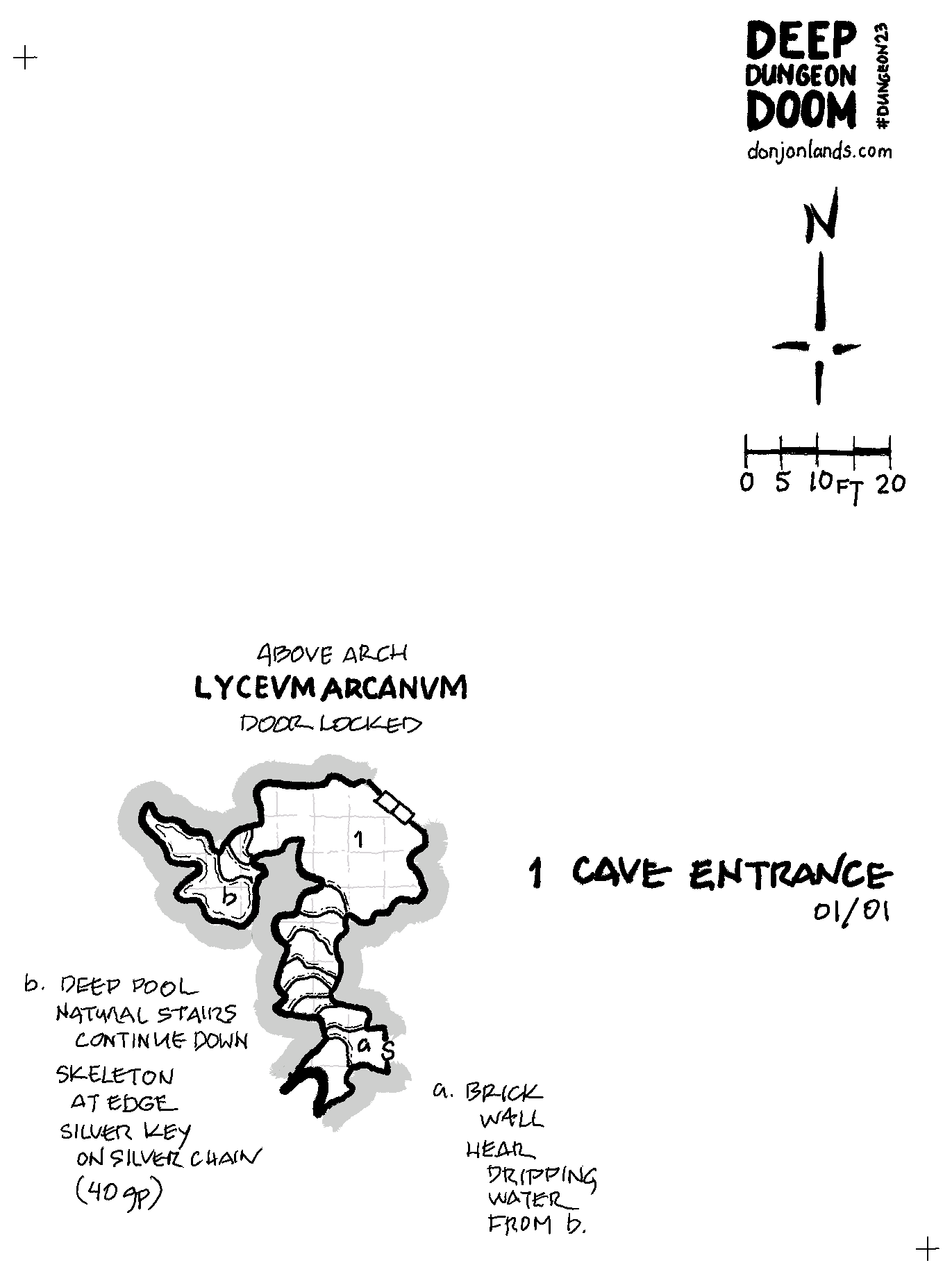Domesday and Environs
In Deep Dungeon Doom, I follow #Gygax75 and #Dungeon23 to create a D&D dungeon campaign in a few minutes per day for one year. I post irregular updates here. To get the daily rooms, follow me on Mastodon and Twitter.
“Step 2 requires sitting down with a large piece of hex ruled paper and drawing a large scale map. A map with a scale of 1 hex = 1 mile … will allow you to use your imagination to devise some interesting terrain and places, and it will be about right for player operations such as exploring, camping, adventuring, and eventually building their strongholds” (Gary Gygax, Europa, April 1975, 18).
Making the Wilderness Map
Scale
We might assume a “large piece of hex ruled paper” is tabloid (A3) size, although I have no idea where one would acquire hex paper in the mid ’70s, especially tabloid size.1 Even at that size, one mile per hex makes what seems to my eyes a too-small area for building strongholds. I suppose I’m used to establishing a barony and having extensive space to explore.
When perusing Dave Arneson’s First Fantasy Campaign (Judges Guild) map and text, though, I imagine a more intimate setting for several PCs and their interactions, the 1977 map’s scale notwithstanding.
Furthermore, with Deep Dungeon Doom’s focus on the dungeon, a small wilderness area feels right, and Ray Otus points out that we’ll have “time to draw a larger scale map in week 5” (The Gygax 75 Challenge, 11).
The reMarkable gives me a hex grid that comes out to ½" hexes on a letter-size page.2 One hex per mile—and limiting the map size to 8" × 10", so as to fit on either US letter-size or European A4 paper—gives us an area of 16 × 20 miles or 320 square miles. Intimate.
Settlements
Following Otus, I place a large town on the coast and a couple villages support-distance away. I like to work in as many terrain types as is logical for a map’s aesthetic appeal and to exercise the wilderness encounter tables, which are differentiated by terrain.
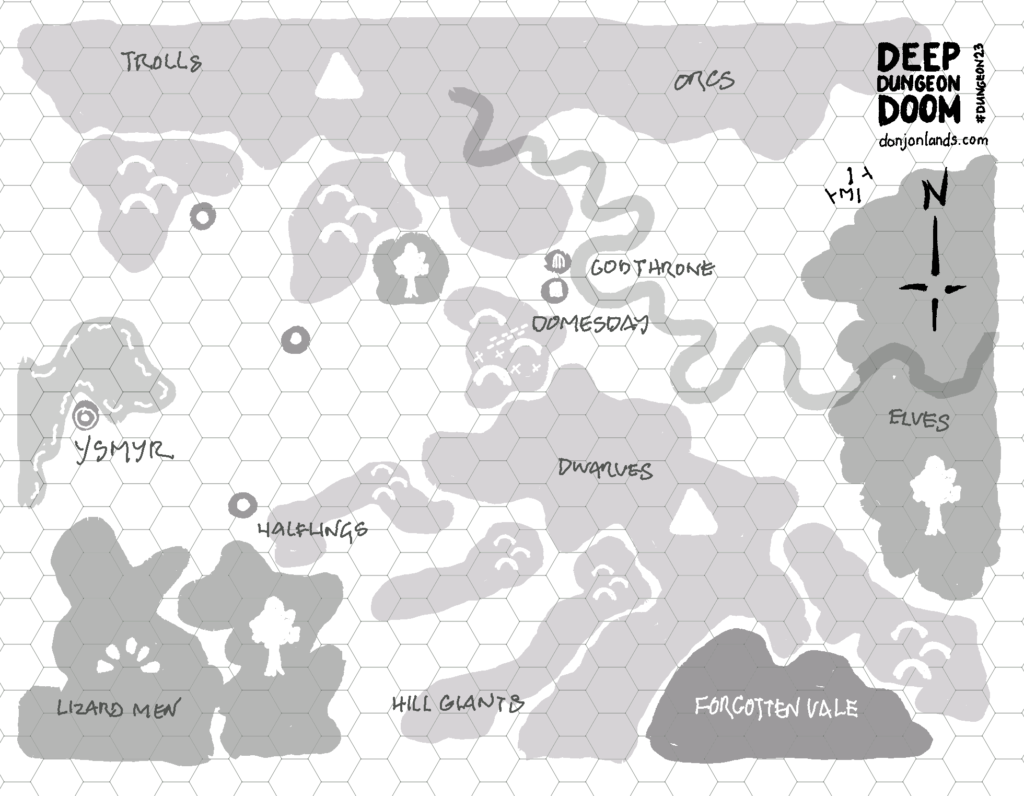
Mysterious Locations
I choose a remote, vacant area between highlands for a mysterious location. I don’t know why the vale is forgotten or why it might be important to the campaign, but I’m guessing it’s got something to do with the Doommaker herself.
Also, inspired by the real-world map source, the central hills connecting the north and south mountain ranges also mark a geographical divide between the eastern highlands and the western lowlands. A long, straight, sloping tunnel runs between the two. Parallel to it, a series of level tunnels joined by sheer precipices runs the same length. Both structures are huge and blocked by rubble, debris, and monsters. A surface-level track also traverses the hills.
Cyclopean Tunnels
The parallel tunnels are a remnant of the Greater Ones. The sloping tunnel was used for ground transport. The other, after the builders diverted the river, was a series of locks for watercraft. The elves of the eastern woods re-diverted the river some longtime ago.
Dungeon and Base Town
The dungeon, which I name after its most prominent feature, is located off-center, and I place the base town—a stronghold—nearby. I also add regions inhabited by PC races, plus monstrous races for tension.
So early in the campaign—the PC party is still practically at the dungeon entrance, I don’t expect the neophyte adventurers to explore the wilderness soon. I highlight only geographical features on the map, marking each with a single large icon, and restrain myself from adding further detail—apart from an encounter table.
Wilderness Encounter Table
I divide the wilderness map into quadrants, marked by the central hills. Entries separated by a pipe “|” should be read west|east; those by a slash “/” north/south. For example, a 3 result yields halflings when traveling in the west or elves while exploring east of the central hills.
| 2d6 | Result |
|---|---|
| 2 | Magic-User (Men*) (L or N) |
| 3 | Halflings|Elves |
| 4 | Knights** |
| 5 | Orcs/Dwarves |
| 6 | Men*|Humanoid* |
| 7 | Roll on Wilderness Encounter Table* |
| 8 | Bandits |
| 9 | Lizard Men|Goblins |
| 10 | Ogres |
| 11 | Trolls/Hill Giants |
| 12 | Magic-User (Men*) (C) |
| * See Wilderness Encounter Table (X57-8). ** Knights? I don’t know yet. |
Daily #Dungeon23 Rooms on Mastodon and Twitter
I post the dungeon map, updated with the day’s room and a brief description, every day on Mastodon and Twitter.
1 Avalon Hill of course. In “Hexmaps and Random Encounters Before D&D,” Tom Van Winkle notes that the makers of Outdoor Survival (1972) sold 22" x 28" hex maps for amateur game designers (Tom Van Winkle’s Return to Gaming, September 2, 2023). In an email exchange, Tom points me to a notice in the July 1964 issue (Vol. 1, No. 2) of the Avalon Hill General. Under the heading “Design Your Own Games” on page 1, AH offers the large hex maps in sheets for $1.00 each.
2 Only interesting for reMarkable users: To achieve half-inch hexes, I use the reMarkable template medium hex grid, portrait orientation, exported to PNG, and printed at 176 ppi. Use the highlighter in different colors and export grayscale to get the varying shades. I have to turn the tablet landscape, because reMarkable got the hex orientation wrong. The engineers maybe never played Outdoor Survival, whose map board has the horizontal lines at top and bottom. This is, therefore, the “correct” orientation.
Added footnote 1. [19:04 8 September 2023 GMT]
Edited footnote 1 to include the source. [5:45 11 September 2023 GMT]
Blue Flame, Tiny Stars on DriveThruRPG
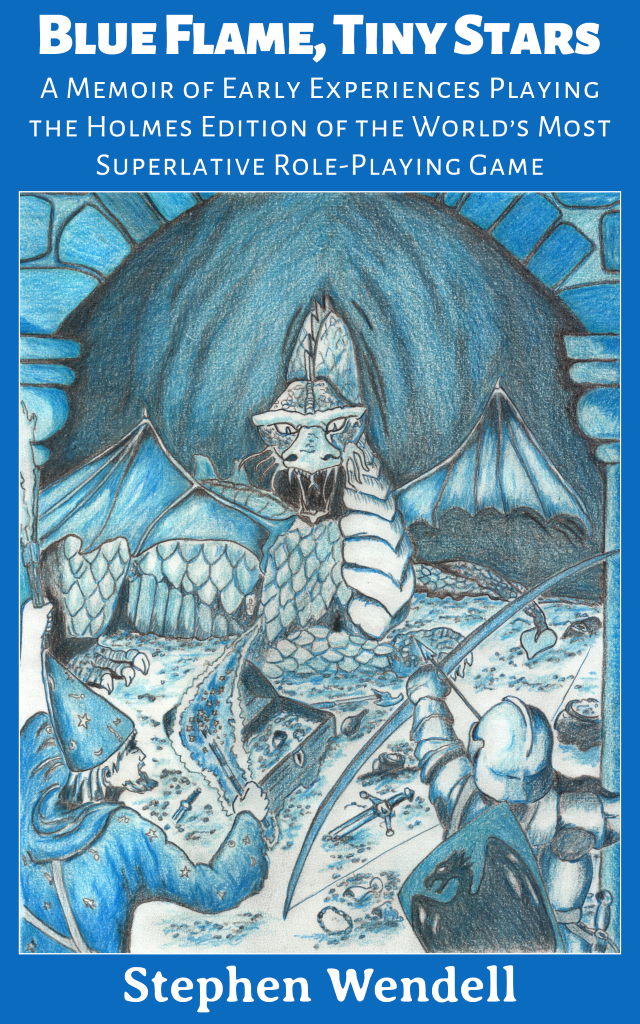
“Stephen’s delightful memoir makes you want to travel upstream to your own formative D&D headwaters, dig out your old graph-paper maps and worn dice, and rediscover the gateway to what the author calls ‘the fantastic path.’”
—Ethan Gilsdorf, author of Fantasy Freaks and Gaming Geeks: An Epic Quest for Reality Among Role Players, Online Gamers, and Other Dwellers of Imaginary Realms
“A celebration of dice, maps, friendship, and, above all, imagination—the very stuff from which the hobby of role-playing is made.”
—James Maliszewski, author of Grognardia: Musings and Memories from a Lifetime of Roleplaying
Warning: Reading this book will make you want to play D&D!

Dirty Fighting
This is the 17th in a continuing series of articles, which reedits house rules for Holmes Basic D&D from 40-year-old game club newsletters. Mentions of house rules are in bold text and followed by a [bracketed category designator].
For rules category descriptions and more about the newsletters, see “About the Reedition of Phenster’s.” For an index of articles, see Coming Up in “Pandemonium Society House Rules.”
Phenster’s Pandemonium Society House Rules is a work of fiction. Names, characters, businesses, events, incidents, and newsletters are either products of the author’s imagination or are used in a fictitious manner. Any resemblance to actual persons, living or dead, or actual events is pure coincidence.
The following excerpts are from Phenster’s contribution to L’avant garde #53 (March 1983). Though out of order, they reproduce the entire article.
Dirty Fighting
Sometimes we want to do something in combat besides attacking with a weapon. Like the time Mandykin had to fight an ogre all by herself after she got separated from the group by a falling portcullis. We couldn't lift the portcullis, so the rest of us went to find another way around. Mandykin found the ogre's lair first. She knew she couldn't beat it in a fair fight, so she had to fight dirty.
She had a bag of salt that we use to throw at zombies, so she threw a handful in the ogre's face, first. She had to make a missile attack with a -4 penalty. She hit, so the ogre was blinded. (Sometimes we throw sand, too, and it's the same.) Then she wanted to trip it. So she rolled her hit dice and added +2 for her high dexterity (17) against the ogre's hit dice. She had 7 4-sided vs. the ogre's 4+1 d8s. It was close but she did it. By the time we found the long way around, Mandykin had the ogre tied up and was sitting on its belly.
Then there was the time we fought a balrog at the edge of the Pit to Hell. Only Beowulf and Jinx had magic weapons, and my spells weren't working on it. Jinx said, "Let's rush it." I said, "What?!" He said, "We'll push it back into the Pit to Hell." I said it was a bad idea, because the balrog could immolate. But Beowulf asked me if I had a better idea and I didn't. Hazard said we should all throw our hit dice (+ damage bonus) against the balrog's hit dice. Only four of us could push, and we got 88 all together. The balrog got 49, so we pushed it into the Pit, but it immolated! We all got burned pretty bad, and Jinx got caught by the balrog's whip and was jerked down into the Pit to Hell.
Shoving, Tripping, and Throwing Sand/Salt
Instead of attacking with a weapon, a combatant may take one of the following actions. A character with multiple attacks with a weapon takes only one of these actions per round.
Hit Dice Roll
Shove [E] and Trip [E], as well as Wrestling [E] farther below, use opposed hit dice rolls. That is, each side rolls dice equal in size and quantity to their hit dice. A 6th-level magic-user rolls 6d4; a 10th-level fighter, 9d8+2.1 Constitution bonuses or penalties to hit points are not counted. The higher roll wins the contest.
Shove [E]
Attackers and defenders make opposed hit dice rolls, adding their Strength bonus or penalty to melee attack.2 A successful shove moves the defender a space in the direction opposite the attacker. Attackers move with the defenders, and the combatants are in close quarters (see Close Quarters). In case of failure, the combatants are in close quarters, but the defenders do not move.
Trip [E]
To trip an opponent, an attacker must step into close quarters with the defender. Attacker and defender then make opposed hit dice rolls, adding their Dexterity bonuses or penalties to AC and missile fire.2 A successful trip indicates the defender is prone. (See Prone [E].) On a failed attempt, the defender may immediately attempt a trip, becoming the attacker. A series of failures takes place in an instant of struggle.
Throw Sand/Salt [P]
The attacker, within 10' of the target, makes a missile attack with a −4 penalty. On a hit, the target must make a saving throw vs. Paralysis or be blinded for 2 to 5 rounds, suffering +2 penalty to AC and −4 to attack rolls.
Note: A penalty to an attack roll to effect a particular result is danger close to allowing PCs to “aim for the eyes” with any attack. When using this [P] Pandemonium rule, be prepared to defend against arguments for such “called shots.”
Source of Opposed Hit Dice Rolls
An opposed hit dice roll is also used in a Shield Wall Push [P] (see “Phalanx Fighting” and “The Phalanx and the Shield Wall.”) I find a similar procedure in the Strategic Review Vol. 1, No. 2 (Summer 1975) under the heading QUESTIONS MOST FREQUENTLY ASKED ABOUT DUNGEONS & DRAGONS RULES (3). In a combat example, a group of orcs grapple with a hero. To be successful, the orcs must roll their combined hit dice and beat the hero’s hit dice roll. Prior to the opposed roll, each orc must make a successful attack roll against the hero before its hit dice can be counted in the grapple. The Pandemonium Society seems to ignore this step.
Nonlethal Attacks
Whenever we have a brawl at the Nine of Pentacles (that's our local Sword & Board), we fight with our fists or wrestle, or we use makeshift weapons, like bottles and chair legs. In a fist fight, you do 1 + STR bonus in NONLETHAL damage, which means, if you go down, you aren't dead, you're just knocked out. Makeshift weapons do 1-3 real damage. We can get in big trouble if we kill someone in base town though, so we have to be careful with that. Wrestling is just another hit dice throw that you add your damage bonus to or your dex bonuses. It doesn't really do any damage, but if you win you can make the other guy do what you want, like pin him to the floor or make him say "Uncle" or just about anything else you can think of.
Fist Fighting [E]
A fist does 1 point of damage. Add the attacker’s Strength bonus2 to damage as normal. All damage is nonlethal.
Knocked Out [E]
When a creature takes nonlethal damage equal to its current hit point total, it falls unconscious for 1 to 6 rounds.
Wrestling [E]
The attacker chooses whether to use Strength or Dexterity and steps into close quarters with the defender. The combatants make opposed hit dice rolls adding the chosen bonus or penalty. If the attacker wins, a desired effect takes place.
Feint
Mandykin wanted a way she could do a feint in melee. Hazard said it was a "subtle action," and it's assumed in a combat round. But Mandykin said a feint is about as subtle as a parry and there's a rule for parry right in the book.
A feint is when you trick your opponent into thinking you're going to do one thing, but then you do something else. You catch him off guard, so you get a bonus (+2) on your attack. It only works against man-type creatures. You do a feint on your go, then you have to wait until your opponent goes to see if he fell for it: Roll a 20-sided die, subtract your level, add your opponent's level or hit dice and his bonus for a high wisdom (if he has one). If you roll under your dexterity score, he's tricked! and takes a -2 to his attack, and you attack at +2. If he isn't tricked, he gets a +2 on his attack (because you left yourself open), and you attack normally.
Feint [P]
To feint, an attacker makes a Dexterity check, subtracting his or her level and adding the opponent’s level (or hit dice), plus the opponent’s Wisdom bonus. If successful, the opponent attacks with a −2 penalty, and the attacker, immediately afterward, makes an attack with a +2 bonus. When the feint fails, the opponent attacks with a +2 bonus, and the attacker with a −2 penalty.
Note: I add the attacker’s −2 penalty in the failure case to discourage overuse, and still I class this one as [P] Pandemonium.
1 We’ll see later that the Pandemonium Society uses hit dice by level progression from Greyhawk (1976, 10-11).
2 Also later, we’ll see ability score bonuses and penalties.
First Twelve Days of Deep Dungeon Doom in Video
A megadungeon in one room a day for 365 days in 2023. These are the first 12 days of Deep Dungeon Doom, a #Dungeon23 project.
Using How to Host a Dungeon for #Dungeon23
“Not playing through it, I use the rules booklet as a reference work. Tony Dowler’s dungeon-building game provides primordial nexuses, ancient civilizations, and master villains to fill out the dungeon’s space and history should need arise.”
—on How to Host a Dungeon, Inspiration, “Campaign Hook: ‘To All Who Enterin—DOOM’”
As a prelude to some future rendition of Deep Dungeon Doom, I’ll play through an extravagant run of How to Host a Dungeon to establish a robust and detailed history for the 24-level adventure locale. By extravagant, I mean: instead of eight, the dungeon spans 24 strata; not one but a few nexus points are planted within; instead of one each, I’ll run several ages of civilization, monsters, and villainy. Even greater in scope than Wyrm Dawn, it’s a dream project for another day.
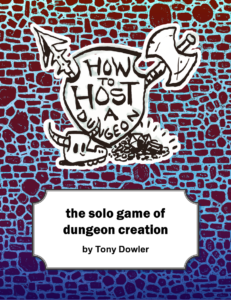
Meanwhile, for this outing, we adhere to #Gygax75 and #Dungeon23’s prime directive: “Don’t overthink it!” How to Host a Dungeon is a reference work. I use elements from the game’s various “ages” as focal points. So, “rooms” that might be built during civilization and villainous periods become sections of the dungeon, principle characters become major historical figures, and a brief outline of history based on the successive ages becomes the framework for hanging past events on a time line.
“The (unobserved) past, like the future, is indefinite and exists only as a spectrum of possibilities.”
—Stephen Hawking & Leonard Mlodinow, The Grand Design
Working Framework for Historical Events in Deep Dungeon Doom
The following table outlines the major historical periods in the dungeon. This is how I see the time line now. Other—perhaps many other—civilizations, monster ages, and villainous periods, certain to have taken place, may be inserted as the campaign progresses. A thing is malleable until it is observed, that is, used in play.
Time Line—Deep Dungeon Doom
| Ages | Primordial Nexuses | Civilizations | Villains |
|---|---|---|---|
| Prehistory | |||
| Void | |||
| Primordial Monsters | |||
| Alien (Illmind) | |||
| Cyclopean Complex | |||
| Godthrone | |||
| Gateway (Abyss) | |||
| Demon | |||
| Devil (empire) | |||
| Bronze Age | |||
| Drow | |||
| Iron Age | |||
| Dwarven | |||
| Giant (empire) | |||
| Dark Age | |||
| Medieval Age | |||
| Magician (Lore Kings) | |||
| Fearthoht (empire) | |||
| [Present] | ? |
This historical framework is mostly for the DM, so to maintain some coherence as I build out dungeon areas. The process also informs the present situation in the dungeon. Player characters might learn some of the dungeon’s history as they explore it, but they are not obliged to. Players themselves may not much care.
Illmind
The Illmind is a sinister collective of hyperintelligent, extra-dimensional beings. It is responsible for the Rending—the cosmic cataclysm that is the campaign world’s origin. (See Song of the World Dragon.) After the cataclysm, the Illmind established a colony at this location. The colony, whose objective is not yet known to me, grew into the dungeon’s first civilization.
The Illmind civilization ends with the construction of the Godthrone (Megastructure) and the Gateway (Uplift Facility). The latter gates in demons to destroy alien works. The former is now called “Godthrone,” but its true purpose is unknown.
Lyceum Arcanum
To get straight into the thick of things, I want to start the campaign with something about the wizards. Looking at the magician civilization’s constructions, I am attracted to “Lyceum Arcanum.” According to How to Host a Dungeon1, this large structure is built at a nexus point either above or below ground (16). I place it on the surface, knowing that, at civilization’s end, it is buried under a new surface level. For the required nexus, I choose Ley Lines, which is one attraction for the immigrant magicians and later generations.
Lore Kings
As it may be of immediate usefulness, we sketch the history of the magician civilization. It is important to note that, when referring here to ages and civilizations and empires, we speak of the local dungeon and its environs. Other ages, civilizations, and empires take place in the greater world, in parallel and at greater scale.
During the dark age that followed the fall of the Giant Empire, mages were drawn to the donjon, a towering remnant of the Greater Ones from before the Rending. As they grew in power, the mages formed a civilization that brought the dark age to an end.
The magician civilization was ruled by a succession of monarchs, who sought arcane lore lost in the Rending. The Lore Kings discovered much but lost it again in their own apocalypse, which sages now call the Time of Vengeance.
Sometime later, Fearthoht Doommaker rose to dominate the dungeon in an age of villainy that ended with her imprisonment. Now, the dungeon has fallen into another age of monsters, in which the Doommaker Cult attempts to free Fearthoht and promote her to godhood.
Meanwhile, other monster groups vie for power—either through amassing wealth or increasing their numbers—in order to become the dungeon’s next master villain. To determine which monsters form what factions would be overthinking it. Details spill from play.
1 Dowler credits Philip LaRose for the Magician Civilization.
Advanced Combat
This is the 16th in a continuing series of articles, which reedits house rules for Holmes Basic D&D from 40-year-old game club newsletters. Mentions of house rules are in bold text and followed by a [bracketed category designator].
For rules category descriptions and more about the newsletters, see “About the Reedition of Phenster’s.” For an index of articles, see Coming Up in “Pandemonium Society House Rules.”
Phenster’s Pandemonium Society House Rules is a work of fiction. Names, characters, businesses, events, incidents, and newsletters are either products of the author’s imagination or are used in a fictitious manner. Any resemblance to actual persons, living or dead, or actual events is pure coincidence.
Losing Balance
In the excerpt on critical misses from “Combat Complications” (L’avant garde #49, September 1982), Phenster refers to losing one’s balance in melee. In “Advanced Combat,” three months later, he adds:
Sometimes, especially whenever we're fighting on rough terrain, when we lose our balance there's a chance we might fall down. We have to roll our dex score or less on a d20. Rough terrain is like a field of rubble, a steep slope, or a dungeon floor where stone blocks have been upset by an earthquake or tree roots growing under them. We can't fight from the floor (+4 AC), and it usually takes a turn to get up.
—from “Advanced Combat,” L’avant garde #51 (December 1982)
As “off balance” appears twice in Phenster’s list of possible results due to a critical miss, when using the rule Critical Miss: Lose Next Action [E], consider Balance [P] as a supplement. I put it in the [P] Pandemonium category, because it adds a dice roll to the end of what should be a quick resolution of a combat action. Another option is for the DM to adjudicate, including the fall (or not) in the critical miss result.
Balance [P]
A character who loses balance on uneven ground (e.g. rough or sloping terrain, stair steps) must make a Dexterity check or fall prone.
Prone [E]
A prone character cannot attack, and any attacks on the prone character are made at +4 on the dice. A prone character can stand in one round.
Drawing a Weapon in Melee
“It takes one melee round to draw a new weapon, but one hanging free, or in the other hand, can be employed immediately” (Holmes 21).
According to the rules you can draw a weapon in one round. You can usually only do one thing at a time, but we say you can also draw a weapon while you move, like when we're closing to melee.
—“Advanced Combat”
Draw Weapon While Moving [E]
A combatant may draw a weapon while moving.
Charging and Other Movement in Combat
In the following excerpt, end 1982, Phenster refers to “fully armored” characters, which I assume he gets from Holmes’s Movement Table (9). In Charge [E] below, I translate to any armor, because in 1984 Phenster adds move rates for characters wearing leather armor: In L’avant garde #63 (May 1984), he places “half armored” characters between unarmored and fully armored on the movement table. He also halves the move rates given on the Holmes table.
Phenster does not specify whether a half armored character gets the damage bonus for charging. I defer to Chainmail, which gives the impetus bonus to heavy and armored footmen (17).
Besides Charge [E] and Half Armored Move Rates [E], Maneuver [E] allows a step in melee.
If you are not more than THREE TIMES your melee move distance away from your opponent, you can charge. But it has to be over flat/level ground without any obstacles, and the opponent has to be at least 10' away. If you hit and you are fully armored, you get a +2 bonus on damage from the impetus. And if you slay your opponent, your charge continues and you can attack again if you charge into another opponent, until the end of your charge. Your charge has to be in a straight line.
—“Advanced Combat”
Charge [E]
When an opponent is at least 10' and not more than thrice combat move distance away, a combatant may charge the opponent in a straight line over level terrain. If the attacker is wearing armor, a charge grants a +2 bonus to damage. If the opponent is slain, the attacker continues the charge up to three times combat move distance, engaging subsequent opponents.
Whereas contemporary D&D editions apply the charge bonus to the attack roll, Phenster applies it to damage. One interpretation of Chainmail’s “Impetus Bonus” (17) would do likewise.
Half Armored Move Rates [E]
Characters wearing leather armor or equivalent move normally at 180 feet per turn. They move at 90 feet per turn while exploring, and 15 feet in a combat round.
Flank and Rear Attacks
If you can attack from a monster's flank (90 degrees from its front), you get +1 on the attack. If you come up behind it, you get +2. You're supposed to add another bonus if the monster has a shield and can't use it (like if you're on its right side), but Hazard doesn't mess with that. He just says attacks from behind get +2 on the roll.
You DO NOT get the bonus for flanking if you're less than 90 degrees from the front. If the monster's fighting somebody else and you come up beside it, you might only get one attack with a bonus before it turns to put both its enemies at 45 degrees to its front.
—from “Combat Complications,” L’avant garde #49 (September 1982)
Flank and Rear Attacks [E]
An attack from a flank gains a +1 bonus on the dice; from the rear, +2. Whether the defender wields a shield or no is not considered. Assume that a combatant can change facing (left, right, or about face) on its count in the initiative order or any time immediately prior to an attack.
Defend in Place
Jinx had a good attack roll for once, and he hit the grimpshee with his sword but didn't do any damage. That's how we knew it was immune to normal weapons. So Jinx stepped to one side of the door and defended in place (-4 AC), while Friar Tombs came up with his snake staff, and Phenster Prime threw protection/evil 10'.
—from “At the Gates of Pandemonium,” Paradigm Lost #4 (December 1982)
Full Defense [E]
A melee combatant may forego all attacks and other actions to devote the round to defense, thereby gaining a −4 bonus to armor class. When so defending, only a step is allowed in the round (see Maneuver [E]).
Fighters vs Humanoids
. . . Orcs everywhere—we were surrounded! Mandykin fired her crossbow then drew a sword. I didn't have any spells left, so I took out my dagger to defend my skin. Friar Tombs struck one with his mace. Then it was the Bully's turn. He swung his two-handed sword once and two orcs fell. He swung again and another one went down. Five more swings and all the orcs were dead or ran away. He got so many attacks because he's a 7th-level fighter. If it was 2 HD monsters, like gnolls or lizard men, then it would be 3 attacks.
—“Advanced Combat”
Fighter Multiple Attacks vs Humanoids [E]
Fighters get multiple attacks per round against humanoids. Divide the fighter’s level by the humanoid’s hit dice, drop any fraction. Treat less than 1 HD monsters as 1 HD, and ignore any bonuses to base hit dice. The fighter makes all attacks at once in the usual order of attacks.
Fighter Damage Splatter vs Humanoids [P]
When a fighter slays an undamaged humanoid with one attack, any extra damage is taken by another humanoid, if it is within the fighter’s reach and would be hit by the same attack roll. If the second humanoid was also undamaged and is slain, any remaining damage is taken by another humanoid meeting the same conditions, and so on.
Because it implies the fighter swipes through multiple enemies with a single swing, this rule, for me, feels over-the-top, so I throw it in the [P] Pandemonium category. It can, however, speed up those big combats, and it makes the fighter player feel good.
Hireling and Monster Reactions in Melee
It didn't make any sense that the PCs can decide to run away when the monsters are too tough, but the monsters don't run away when it's plain they're going to be slaughtered. Our NPCs might lose their nerve too, and they might run. Hazard mostly just decides for the monsters and NPCs when their going gets tough. But when he isn't sure, he uses the Hostile/Friendly table from the rulebook to see if the monsters will cut their losses and run. He gives the monsters a number depending on how brave they are. Most monsters fall into the 6 to 8 range. Hired NPCs usually get a 7. For example, kobolds have an 8 morale (Normally courageous), ogres have a 5 (Sturdy), and dragons have a 3. And Clare Brighthelm, a Knight of the Celestial Hart, is Stalwart; she never backs down from a fight.
2: Stalwart, never runs away, never surrenders
3-5: Sturdy, fierce, battle-hardened
6-8: Normally courageous
9-11: Weak of will
12: Coward, always runs away
Whenever the monsters could have a second thought about going on with the fight, Hazard rolls two d6s. If he rolls below the number, the monsters run (or give up if they can't escape). But if he rolls the number or higher, they fight on.
—“Advanced Combat”
Morale [E]
The DM assigns a moral score based on his or her judgment and interpretation of the creature crossed with Phenster’s table. Hirelings begin with a morale score of 7. On a 2d6-roll result lower than the moral score, the creatures flee or surrender. When to check morale is also left to the DM’s discretion.
DMs who find Hazard’s system too haphazard may consult B/X (Moldvay, Cook, Marsh, 1981) for a similar system more fully detailed.
Campaign Hook: “To All Who Enter Herein—DOOM”
In Deep Dungeon Doom, I follow #Gygax75 and #Dungeon23 to create a D&D dungeon campaign in a few minutes per day for one year. I intend to post irregular updates here. To get the daily rooms, follow me on Mastodon and Twitter.
Gary Gygax, in the Europa article (April 1975), notes mythology, folklore, and fantasy and swords & sorcery literature as typical sources of inspiration.
“Settings based upon the[se] limits (if one can speak of fantasy limits) can be very interesting in themselves, providing the scope of the setting will allow the players relative free-reign to their imaginations” (18).
In addition to listing our inspirational sources, Ray Otus suggests we write a few concise bullet points in describing the campaign setting to arouse the players’ excitement (The Gygax 75 Challenge, 7). My general inspiration, as well as two of five specific sources, comes rather more from D&D itself. The dragon eats its tail.
Mimicking a source, I preface the lot with a brief background. And, because Winninger’s Dungeoncraft is in my DNA, I make up a secret, which I hide behind a spoiler tag. Those who wish to explore the dungeon in play should not peek.
Background
“…the dungeons beneath the ‘huge ruined pile, a vast castle built by generations of mad wizards and insane geniuses.’”
—Gygax and Arneson, Men & Magic (D&D Vol. 1, 5)
The last of these mad wizards desired godhood. In a laboratory on the dungeon’s lowest level, Daerdread Fearthoht constructed a device that would channel divine energy. She had only to capture a god. A religious order tricked the wizard, trapping her in the device, thus preventing the apotheosis and rendering the wizard impotent. But not before Fearthoht, now called Doommaker, threw a powerful curse on the dungeon: “To all who enter herein—DOOM!”
Doommaker
Fearthoht feigns impotence. Though trapped in Godthrone, she communes with a sect of evil mage-priests devoted to the would-be deity. The mage-priests have reversed the energy flow between trap and device. Their continuous prayers restore the wizard’s power.
Description
- DONJON LANDS setting: The campaign takes place in a far-future Earth: “a world with magic, monsters, and a ring around it, with stars that aren’t fixed but dance and swirl.” See also its creation myth Song of the World Dragon.
- Medieval Greek and Roman culture: An empire recently encompassed the known world. Following a collapse of imperial power in the west, an overlord retains power over eastern realms.
- Dungeon campaign: Game play focuses on dungeon exploration with occasional wilderness forays.
- Wizard opposition: The principal villains are Fearthoht Doommaker and an array of powerful wizards and their many and diverse minions.
- Fun-house dungeon: Encounters and adventures are intended to be fun without so much attention to fantastic realism.
- Deadly: The mood is doom.
fun house noun
: a building in an amusement park that contains various devices designed to startle or amuse
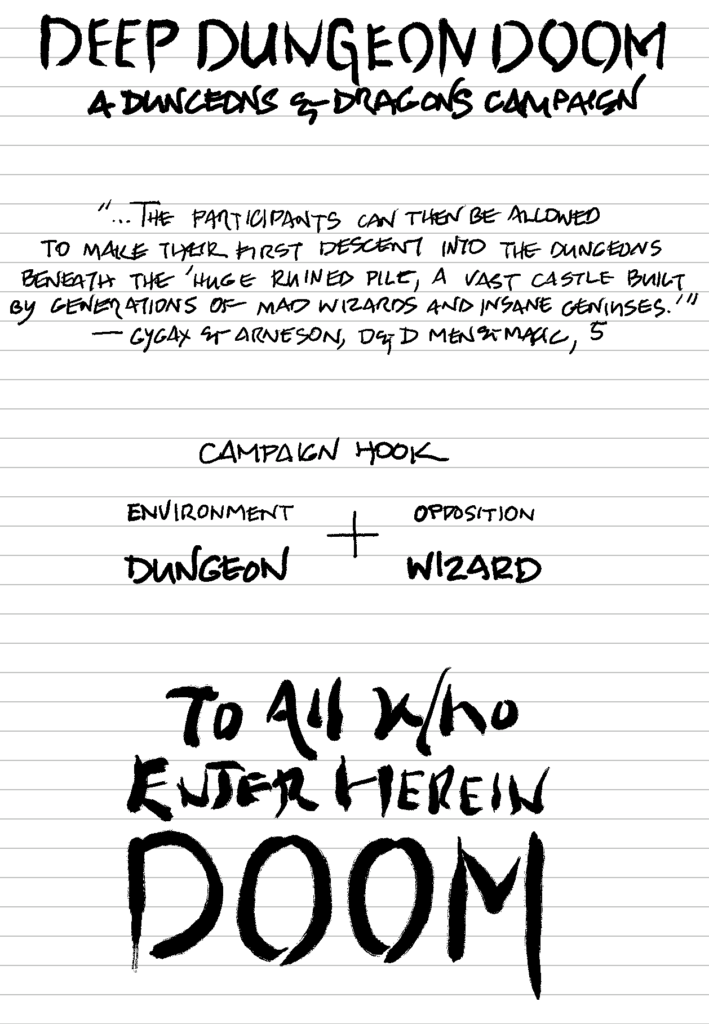
Inspiration
- Tegel Manor: Commonly considered the original fun-house dungeon, the 1977 Judges Guild module’s terse descriptions also lend well to #Dungeon23’s short-handed stocking method.1
- Magic-users of Jack Vance and Clark Ashton Smith: Various works of these two authors portray the sort of “mad wizards and insane geniuses” I’m looking for.
- How to Host a Dungeon: Not playing through it, I use the rules booklet as a reference work. Tony Dowler’s dungeon-building game provides primordial nexuses, ancient civilizations, and master villains to fill out the dungeon’s space and history should need arise. I may elaborate on this point later.
- World history: The campaign is set in a place and time similar to the 11th-century Byzantine Empire.
- Greek and Roman mythologies: Gods and religion are drawn from an amalgam of these two real-world mythologies.
My notebook is a reMarkable tablet.
1 “365 rooms written like ‘3 orcs, 25 gold pieces’ is better than 5 rooms written like ‘In this beautiful hand carved obsidian room sit 3 orcs arguing over a dice game. 25gp sit on the table, each of them…’ See what I’m getting at?”—Sean McCoy, “#Dungeon23”
Follow Stephen on Mastodon and Twitter.
1 Cave Entrance
In Deep Dungeon Doom, I follow #Gygax75 and #Dungeon23 to create a D&D dungeon campaign in a few minutes per day for one year. Not to flood the blog with rooms for this project, I intend to post irregular updates.
Other points of ingress exist. The campaign begins at the cave entrance.
1 Cave Entrance
Above arch: LYCEVM ARCANVM. Door locked.
a. Brick wall. Hear dripping water from b.
b. Deep pool. Natural stairs continue down. Skeleton at edge. Silver key on silver chain (40 gp).
